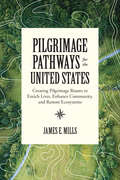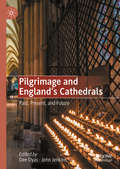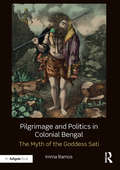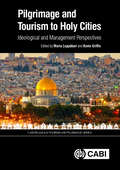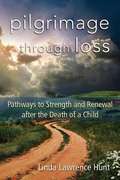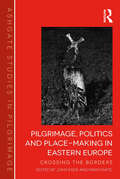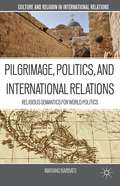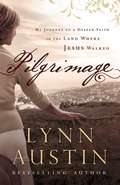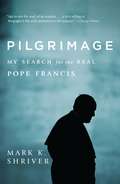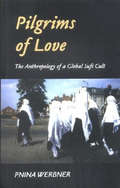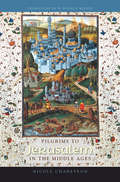- Table View
- List View
Pilgrimage In Islam
by Huseyin YagmurAn extensive manual describing the Hajj'a journey that enlightens the significance of human existence and submission--this guidebook offers advice for those undertaking the holy voyage and gives the meanings behind its rituals. With special attention to the people who make the journey--approximately three million Muslims a year--this reference illuminates the importance of one of the fundamental forms of Islamic worship as a social and cosmic transformation.
Pilgrimage Pathways for the United States: Creating Pilgrimage Routes to Enrich Lives, Enhance Community, and Restore Ecosystems
by James E. MillsAn inspirational argument for the creation of a new pilgrimage tradition in the United States.Pilgrimage is a sacred tradition that has existed around the world for centuries. Every year, more than one hundred million devotees from different cultures and faiths embark on journeys to such holy sites as Santiago de Compostela, Mecca, and Banaras. For some, making a pilgrimage is a spiritual act, while for others it is a secular experience of personal restoration. And yet there has never existed a tradition of pilgrimage within the United States.Cultural geographer James E. Mills makes a compelling case for the creation of a network of American pilgrimage routes to heal societal divisions and foster a new ethos of humanitarianism and environmentalism. He also addresses practical considerations for the development, ownership, and administration of future routes. Pilgrimage Pathways for the United States is for anyone considering a pilgrimage and for those of us who are interested in connecting and protecting our natural world, including environmentalists, interfaith clergy, political leaders, community developers, and activists.
Pilgrimage and England's Cathedrals: Past, Present, and Future
by John Jenkins Dee Dyas"A brilliant breakthrough in pilgrimage studies. An exemplary study that shows how to bring together different academic and institutional interests in a common cause – understanding the relationship between pilgrimage and English cathedrals over time. A publication that will, hopefully, inspire similar collaborative studies around the globe."- John Eade, Professor of Sociology and Anthropology, University of Roehampton, UK"People who oversee, minister, lead worship, guide, welcome, manage, market, promote and maintain cathedrals will find this book an indispensable treasure. It is aware of the awesome complexity inherent in cathedral life but it doesn’t duck the issues: its clear-eyed focus is on the way people experience cathedrals and how these extraordinary holy places can speak and connect with all the diversity represented by the people who come to them. In a spiritually-hungry age, this book shows us how to recognise and meet that hunger. This book will be required reading for all us “insiders” trying to invite and signpost access to holy ground."- The Very Reverend Adrian Dorber, Dean of Lichfield, Chair of the Association of English CathedralsThis book looks at England's cathedrals and their relationship with pilgrimage throughout history and in the present day. The volume brings together historians, social scientists, and cathedral practitioners to provide groundbreaking work, comprising a historical overview of the topic, thematic studies, and individual views from prominent clergy discussing how they see pilgrimage as part of the contemporary cathedral experience.
Pilgrimage and Political Economy: Translating the Sacred
by Simon Coleman John EadePilgrimage has always had a tendency to follow—and sometimes create—trade routes. This volume explores how wider factors behind transnational and global mobility have impacted on pilgrimage activity across the world, and examines the ways in which pilgrimage relates to migration, diaspora, and political cooperation or conflict across nation-states. Furthermore, it brings together case studies that explore forms of mobility where pilgrimage is juxtaposed, complements, or is in intimate association with other forms of movement.
Pilgrimage and Politics in Colonial Bengal: The Myth of the Goddess Sati
by Imma RamosFrom the late nineteenth century onwards the concept of Mother India assumed political significance in colonial Bengal. Reacting against British rule, Bengali writers and artists gendered the nation in literature and visual culture in order to inspire patriotism amongst the indigenous population. This book will examine the process by which the Hindu goddess Sati rose to sudden prominence as a personification of the subcontinent and an icon of heroic self-sacrifice. According to a myth of cosmic dismemberment, Sati’s body parts were scattered across South Asia and enshrined as Shakti Pithas, or Seats of Power. These sacred sites were re-imagined as the fragmented body of the motherland in crisis that could provide the basis for an emergent territorial consciousness. The most potent sites were located in eastern India, Kalighat and Tarapith in Bengal, and Kamakhya in Assam. By examining Bengali and colonial responses to these temples and the ritual traditions associated with them, including Tantra and image worship, this book will provide the first comprehensive study of this ancient network of pilgrimage sites in an art historical and political context.
Pilgrimage and Tourism to Holy Cities
by Kevin Griffin Maria LeppäkariThis book covers the ideological motives and religious perceptions behind travel to sites prescribed with sanctity in Judaism, Christianity and Islam. It covers sites that have drawn pilgrims and religious tourists to them for hundreds of years, and seeks to provide an understanding of the complex world of religiously motivated travel. Beginning with contemporary perspectives of pilgrimage across these religions, it then discusses management aspects such as logistics, infrastructure, malevolent behavior and evangelical volunteers. This book: - Provides a collection of new, contemporary perspectives on pilgrimage. - Reviews the ideological motives, history, mental health, and religious perceptions of tourism to holy cities. - Contains practical applications, models and illustrations of religious tourism and pilgrimage management from a variety of international and academic perspectives. Written by subject experts, this book addresses cultural sustainability for researchers and practitioners within religious tourism, religious studies, geography and anthropology.
Pilgrimage and Tourism to Holy Cities: Ideological and Management Perspectives (CABI Religious Tourism and Pilgrimage Series)
by Kevin Griffin Maria LeppäkariThis book covers the ideological motives and religious perceptions behind travel to sites prescribed with sanctity in Judaism, Christianity and Islam. It covers sites that have drawn pilgrims and religious tourists to them for hundreds of years, and seeks to provide an understanding of the complex world of religiously motivated travel. Beginning with contemporary perspectives of pilgrimage across these religions, it then discusses management aspects such as logistics, infrastructure, malevolent behaviour and evangelical volunteers. This book: - Provides a collection of new, contemporary perspectives on pilgrimage. - Reviews the ideological motives, history, mental health, and religious perceptions of tourism to holy cities. - Contains practical applications, models and illustrations of religious tourism and pilgrimage management from a variety of international and academic perspectives. Written by subject experts, this book addresses cultural sustainability for researchers and practitioners within religious tourism, religious studies, geography and anthropology.
Pilgrimage in Islam: Traditional and Modern Practices (The Foundations of Islam)
by Sophia Rose ArjanaIt is not only the holy cities of Mecca and Karbala to which Muslim pilgrims travel, but a wide variety of sacred sites around the world. Journeys are undertaken to visit graves of important historical and religious individuals, the tombs of saints, and natural sites such as mountaintops and springs. Exploring the richness and diversity of traditions practiced by the 1.5 billion Muslims across the world, Sophia Rose Arjana provides a rigorous theoretical discussion of pilgrimage, ritual practice and the nature of sacred space in Islam, both historically and in the present day. This all-encompassing survey covers issues such as time, space, tourism, virtual pilgrimages and the use of computers and smartphone apps. Lucidly written, informative and accessible, it is perfectly suited to students, scholars and the general reader seeking a comprehensive picture of the defining ritual of religious pilgrimage in Islam.
Pilgrimage in Practice: Narration, Reclamation And Healing (Cabi Religious Tourism And Pilgrimage Series)
by Ian S. McIntosh Shirley Du Plooy Alison T. Smith E. Moore Quinn Vivienne Keely Matthew R. Anderson Mary Farrelly Tessa Garton George D. Greenia Richard LeSueur Suzanne Van Der BeekPilgrimage in Practice: Narration, Reclamation and Healing provides an interdisciplinary approach to the topic. It reveals many aspects of the practice of pilgrimage, from its nationalistic facets to its effect on economic development; from the impact of the internet to questions of globalization; from pilgrimage as protest to pilgrimage as creative expression in such media as film, art and literature. - Contests the very definitions of pilgrimage and challenges its paradigms. - Provides multiple perspectives on the subject to give a rounded and comprehensive review. - Covers past and present definitions of the sacred journey, the telling of stories, and historical injustices and their remedies through pilgrimage. Perhaps best understood as a form of heritage tourism or tourism with a conscience, pilgrimage (as with touristic travel) contains a measure of transformation that is often deep and enduring, making it a fascinating area of study. Reviewing social justice in the context of pilgrimage and featuring a diverse collection of interdisciplinary voices from across the globe, this book is a rich collection of papers for researchers of pilgrimage and religious and heritage tourism.
Pilgrimage in Practice: Narration, Reclamation and Healing (CABI Religious Tourism and Pilgrimage Series)
by Shirley Du Plooy Alison T. Smith E. Moore Quinn Vivienne Keely Matthew R. Anderson Mary Farrelly Tessa Garton George D. Greenia Richard LeSueur Dr Ian S. McIntosh Aateka Khan Suzanne Van BeekPilgrimage in Practice: Narration, Reclamation and Healing provides an interdisciplinary approach to the topic. It reveals many aspects of the practice of pilgrimage, from its nationalistic facets to its effect on economic development; from the impact of the internet to questions of globalization; from pilgrimage as protest to pilgrimage as creative expression in such media as film, art and literature. - Contests the very definitions of pilgrimage and challenges its paradigms. - Provides multiple perspectives on the subject to give a rounded and comprehensive review. - Covers past and present definitions of the sacred journey, the telling of stories, and historical injustices and their remedies through pilgrimage. Perhaps best understood as a form of heritage tourism or tourism with a conscience, pilgrimage (as with touristic travel) contains a measure of transformation that is often deep and enduring, making it a fascinating area of study. Reviewing social justice in the context of pilgrimage and featuring a diverse collection of interdisciplinary voices from across the globe, this book is a rich collection of papers for researchers of pilgrimage and religious and heritage tourism.
Pilgrimage in the Hindu Tradition: Salvific Space (Routledge Hindu Studies Series)
by Knut A. JacobsenSalvific space is one of the central ideas in the Hindu traditions of pilgrimage, and concerns the ability of space, especially sites associated with bodies of water such as rivers and lakes, to grant salvific rewards. Focusing on religious, historical and sociological questions about the phenomenon, this book investigates the narratives, rituals, history and structures of salvific space, and looks at how it became a central feature of Hinduism. Arguing that salvific power of place became a major dimension of Hinduism through a development in several stages, the book analyses the historical process of how salvific space and pilgrimage in the Hindu tradition developed. It discusses how the traditions of salvific space exemplify the decentred polycentrism that defines Hinduism. The book uses original data from field research, as well as drawing on main textual sources such as Mahābhārata, the Purāṇas, the medieval digests on pilgrimage places (tīrthas), and a number of Sthalapurāṇas and Māhātmyas praising the salvific power of the place. By looking at some of the contradictions in and challenges to the tradition of Hindu salvific space in history and in contemporary India, the book is a useful study on Hinduism and South Asian Studies.
Pilgrimage in the Marketplace: Pilgrimage In The Marketplace (Routledge Studies in Pilgrimage, Religious Travel and Tourism)
by Ian ReaderThe study of pilgrimage often centres itself around miracles and spontaneous populist activities. While some of these activities and stories may play an important role in the emergence of potential pilgrimage sites and in helping create wider interest in them, this book demonstrates that the dynamics of the marketplace, including marketing and promotional activities by priests and secular interest groups, create the very consumerist markets through which pilgrimages become established and successful – and through which the ‘sacred’ as a category can be sustained. By drawing on examples from several contexts, including Japan, India, China, Vietnam, Europe, and the Muslim world, author Ian Reader evaluates how pilgrimages may be invented, shaped, and promoted by various interest groups. In so doing he draws attention to the competitive nature of the pilgrimage market, revealing that there are rivalries, borrowed ideas, and alliances with commercial and civil agencies to promote pilgrimages. The importance of consumerism is demonstrated, both in terms of consumer goods/souvenirs and pilgrimage site selection, rather than the usual depictions of consumerism as tawdry disjunctions on the ‘sacred.’ As such this book reorients studies of pilgrimage by highlighting not just the pilgrims who so often dominate the literature, but also the various other interest groups and agencies without whom pilgrimage as a phenomenon would not exist.
Pilgrimage of a Soul: Contemplative Spirituality for the Active Life
by Shauna Niequist Phileena HeuertzPilgrimage of a Soul
Pilgrimage on the Path of Love
by Barbara Ann BriggsPilgrimage on the Path of Love is the story of a woman on the spiritual path who travels alone to India. Arriving in New Delhi, expecting to be her publisher's guest, she finds herself instead in a Buddhist guest house with lamas from Ladakh. There she is introduced to Tibetan Buddhism and befriends a lama. Traveling to a Himalayan hill station to write, and living very simply, she meets people from all over the world who share their wisdom of life. While living in a Buddhist monastery, she experiences a deepening of faith in the eternal harmony of creation. Finally, she embarks on a momentous journey to Ladakh, The Last Shangri-La, to await the lama she loves. There, her faith is severely tested, but in the end, she emerges as a fuller human being with a more mature understanding of the true nature of life and love.
Pilgrimage through Loss: Twelve Pathways to Strength and Renewal after the Death of a Child
by Linda Lawrence HuntThe death of a child immerses parents into a life-long challenge of living with one of life's most heartbreaking losses. Pilgrimage through Loss tells the story of one family's journey, along with interviews from thirty other mothers and fathers who add their voices to the silences that often surround suffering in our 'mourning-avoidant' culture. Hunt illuminates the varied pathways parents eventually discover that open their lives to strength and healing. Rather than prescribing a path that will lead to recovery, Hunt encourages parents to find the pathways that work for them as they seek to engage life again with meaning and hope. Each chapter includes questions for reflection and discussion, plus recent research on grief and loss. Pilgrimage through Loss not only helps grieving parents, it also provides an insightful resource for those wanting to understand and come alongside a family in grief.
Pilgrimage to the National Parks: Religion and Nature in the United States (Routledge Studies in Pilgrimage, Religious Travel and Tourism)
by Lynn Ross-BryantNational Parks – ‘America’s Best Idea’ – were from the first seen as sacred sites embodying the God-given specialness of American people and American land, and from the first they were also marked as tourist attractions. The inherent tensions between these two realities ensured the parks would be stages where the country’s conflicting values would be performed and contested. As pilgrimage sites embody the values and beliefs of those who are drawn to them, so Americans could travel to these sacred places to honor, experience, and be restored by the powers that had created the American land and the American enterprise. This book explores the importance of the discourse of nature in American culture, arguing that the attributes and symbolic power that had first been associated with the ‘new world’ and then the ‘frontier’ were embodied in the National Parks. Author Ross-Bryant focuses on National Parks as pilgrimage sites around which a discourse of nature developed and argues the centrality of religion in understanding the dynamics of both the language and the ritual manifestations related to National Parks. Beyond the specific contribution to a richer analysis of the National Parks and their role in understanding nature and religion in the U.S., this volume contributes to the emerging field of ‘religion and the environment,’ larger issues in the study of religion (e.g. cultural events and the spatial element in meaning-making), and the study of non-institutional religion.
Pilgrimage, Politics and Place-Making in Eastern Europe: Crossing the Borders (Routledge Studies in Pilgrimage, Religious Travel and Tourism)
by John Eade Mario KatićSince the beginning of the anthropology of pilgrimage, scant attention has been paid to pilgrimage and pilgrim places in central, eastern and south-eastern Europe. Seeking to address such a deficit, this book brings together scholars from central, eastern and south-eastern Europe to explore the crossing of borders in terms of the relationship between pilgrimage and politics, and the role which this plays in the process of both sacred and secular place-making. With contributions from a range of established and new academics, including anthropologists, historians and ethnologists, Pilgrimage, Politics and Place-Making in Eastern Europe presents a fascinating collection of case studies and discussions of religious, political and secular pilgrimage across the region.
Pilgrimage, Politics, and International Relations
by Mariano BarbatoA standout contribution to post-secular IR theory, this book addresses issues of global politics, from cooperation to conflict, and shows how a religious metaphor, the pilgrim, can help us to rethink our concepts of self, agency, and community in a time of changing world order.
Pilgrimage: My Journey to a Deeper Faith in the Land Where Jesus Walked
by Lynn AustinWe all encounter times when our spirit feels dry, when doubt looms.<P><P> The opportunity to tour Israel came at a good time. For months, my life has been a mindless plodding through necessary routine, as monotonous as an all-night shift on an assembly line. Life gets that way sometimes, when nothing specific is wrong but the world around us seems drained of color. Even my weekly worship experiences and daily quiet times with God have felt as dry and stale as last year's crackers. I'm ashamed to confess the malaise I've felt. I have been given so much. Shouldn't a Christian's life be an abundant one, as exciting as Christmas morning, as joyful as Easter Sunday? <P> With gripping honesty, Lynn Austin pens her struggles with spiritual dryness in a season of loss and unwanted change. Tracing her travels throughout Israel, Austin seamlessly weaves events and insights from the Word . . . and in doing so finds a renewed passion for prayer and encouragement for her spirit, now full of life and hope.
Pilgrimage: My Search for the Real Pope Francis
by Mark K. ShriverA down-to-earth and deeply intimate portrait of Pope Francis and his faith, based on interviews with the men and women who knew him simply as Jorge Mario Bergoglio Early on the evening of March 13, 2013, the newly elected Pope Francis stepped out onto the balcony of St. Peter's Basilica and did something remarkable: Before he imparted his blessing to the crowd, he asked the crowd to bless him, then bowed low to receive this grace. In the days that followed, Mark K. Shriver--along with the rest of the world--was astonished to see a pope who paid his own hotel bill, eschewed limousines, and made his home in a suite of austere rooms in a Vatican guesthouse rather than the grand papal apartment in the Apostolic Palace. By setting an example of humility and accessibility, Francis breathed new life into the Catholic Church, attracting the admiration of Catholics and non-Catholics alike. In Pilgrimage, Shriver retraces Francis's personal journey, revealing the origins of his open, unpretentious style and explaining how it revitalized Shriver's own faith and renewed his commitment to the Church. To help us understand how Jorge Mario Bergoglio became Pope Francis, Shriver travels to Bergoglio's native Argentina to meet with the people who knew him as a child, as a young Jesuit priest, and as a reformist bishop. Shriver visits the confessional where Bergoglio first felt called to a faith-based life and takes us to the humble parish where the future pontiff's pastoral career began: in a church created from a converted vegetable shed in an area just outside the city of Buenos Aires. In these impoverished surroundings, Bergoglio answered Christ's call to feed the hungry, clothe the naked, and shelter the homeless, following the example set by his papal namesake, St. Francis of Assisi. In this deeply reported yet highly personal book, Mark K. Shriver explores how Francis's commitment has struck a chord in the hearts of millions who long to make faith, love, humility, and mercy part of their lives as they go out into the world to serve and learn from the most marginalized.
Pilgrims Pray
by Fr. Thomas DubayIn a lucid style, Dubay explores the richness of scriptural prayer themes to be found in the biblical word.
Pilgrims and Pilgrimages as Peacemakers in Christianity, Judaism and Islam (Compostela International Studies in Pilgrimage History and Culture)
by Antón M. PazosPilgrimages can be analysed as acts of conflict - such as the Crusades - or also as platforms for relationship building and rapprochement between religions. With a set of contributions from leading experts in the field, this book explores the concept of pilgrimage in Christianity, Judaism and Islam. Some specific examples of pilgrimages that helped to strengthen links between different religions or civilisations are explored, ranging from Europe to Asia and from the Middle Ages to the twentieth century. Even though every pilgrimage that is investigated here has helped to link different worlds, the case studies show that this relationship rarely led to a better in inter-understanding. Nowadays, peaceful coexistence seems to be its greatest achievement.
Pilgrims in Their Own Land: 500 Years of Religion in America
by Martin E. Marty"Pilgrims in Their Own Land" is in one sense a study of migration, with each wave of immigrants bringing a set of religious beliefs to a new world. The narrative unfolds through sharply detailed biographical vignettes-stories of religious "pathfinders", including William Penn, Mary Baker Eddy, Henry David Thoreau, and many other leaders of movements, both marginal and mainstream. In addition, Marty considers the impact of religion on social issues such as racism, feminism, and utopianism. And engrossing, highly readable, and comprehensive history, "Pilgrims in Their Own Land" is written with respect, appreciation, and insight into the multitude of religious groups that represent expressions of spirituality in America.
Pilgrims of Love: The Anthropology of a Global Sufi Cult
by Pnina Werbner"... will be of interest not only to those concerned with Pakistan and the new Muslim presence in Europe, but also to those interested in an anthropological study of religion." --Barbara Metcalf, University of California, DavisPnina Werbner traces the development of a Sufi Naqshbandi order founded by a living saint, Zindapir, whose cult originated in Pakistan and has extended globally to Britain, Europe, the Middle East, and southern Africa. Drawing on 12 years of fieldwork in Pakistan and Great Britain, she elucidates the complex organization of Sufi orders as regional and transnational cults, and examines how such cults are manifested through ritual action and embodied in sacred mythology and global diasporas. A focus of the study is the key event in the order's annual ritual cycle, a celebration in which tens of thousands of people gather at the saint's lodge in Pakistan and in the streets of Britain. Werbner challenges accepted anthropological and sociological truths about Islam and modernity, and reflects on her own role as ethnographic observer. Pilgrims of Love is a major contribution to our understanding of disaporic Islamic practices, highlighting the vitality of Sufi orders in the postcolonial world.
Pilgrims to Jerusalem in the Middle Ages
by Nicole ChareyronAs medieval pilgrims made their way to the places where Jesus Christ lived and suffered, they experienced, among other things: holy sites, the majesty of the Egyptian pyramids (often referred to as the "Pharaoh's granaries"), dips in the Dead Sea, unfamiliar desert landscapes, the perils of traveling along the Nile, the customs of their Muslim hosts, Barbary pirates, lice, inconsiderate traveling companions, and a variety of difficulties, both great and small. In this richly detailed study, Nicole Chareyron draws on more than one hundred firsthand accounts to consider the journeys and worldviews of medieval pilgrims. Her work brings the reader into vivid, intimate contact with the pilgrims' thoughts and emotions as they made the frequently difficult pilgrimage to the Holy Land and back home again. Unlike the knights, princes, and soldiers of the Crusades, who traveled to the Holy Land for the purpose of reclaiming it for Christendom, these subsequent pilgrims of various nationalities, professions, and social classes were motivated by both religious piety and personal curiosity. The travelers not only wrote journals and memoirs for themselves but also to convey to others the majesty and strangeness of distant lands. In their accounts, the pilgrims relate their sense of astonishment, pity, admiration, and disappointment with humor and a touching sincerity and honesty.These writings also reveal the complex interactions between Christians, Jews, and Muslims in the Holy Land. Throughout their journey, pilgrims confronted occasionally hostile Muslim administrators (who controlled access to many holy sites), Bedouin tribes, Jews, and Turks. Chareyron considers the pilgrims' conflicted, frequently simplistic, views of their Muslim hosts and their social and religious practices.

